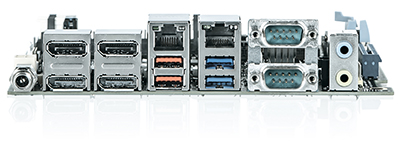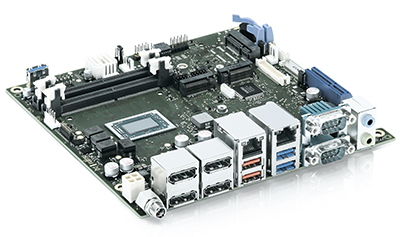Visualization with wow-effect
Powerful AMD Ryzen™ Embedded based motherboards from Kontron
With the acquisition of Fujitsu's industrial motherboard business, Kontron has expanded its embedded motherboard solutions capability to include a customer base that places particular emphasis on rich graphics. Primarily, these are providers of casino gaming systems and medical displays as well as Thin Clients and industrial PCs. The new AMD Ryzen™ Embedded V1000/R1000 processor-based Kontron D3713-V/R mini-ITX motherboard is now available for these highly innovative application areas.

While this new solution from Kontron is a product of Fujitsu's design roadmap, it represents a new landmark for quality 'designed & manufactured in Germany'. It also points the way forward for a whole range of other motherboards from Kontron. Peter Hoser, former Director of Mainboard Sales at Fujitsu and now Vice President and Head of Product Center Boards at Kontron, took the time to elaborate on the progress of integration and Kontron's further motherboard strategy, as well as the new industrial mini-ITX board.
As a former employee of Fujitsu, how successful do you judge the integration of Fujitsu's industrial motherboard business at Kontron to have been?
First of all, it is very gratifying that Kontron will continue Fujitsu's successful industrial mainboard business which is also in the interests of its long-standing customers. Long-term supply, technical support, repair service and continuation of the product portfolio are thus in professional hands and reliably secured for customers. The complex integration of the business is running at full speed in all areas such as sales, purchasing and production, development and support. The customer will not have noticed any of these extensive tasks and changes. The transfer of the operative business took place smoothly in October 2019 without any delivery shortages. The next steps will be the integration of development and the relocation of motherboard production. During my 33 years at Fujitsu, I worked for five years as a process engineer in the production of motherboards and therefore am well aware of how complex the relocation of such a production alone can be, even for a supposedly short distance from Fujitsu in Augsburg, Germany, to KATEK - Kontron's long-standing manufacturing partner who is also located in Bavaria, Germany. However, I am very pleasantly surprised at how professionally this is being handled by all the companies involved - Fujitsu, KATEK and Kontron. For example, the first motherboard models were successfully relocated by the end of 2019. Further models will follow in the coming months by April 2020.
It is also pleasing to note that new products have also been launched and decisively developed in the meantime. Among them is our latest highlight: an AMD Ryzen™ Embedded V1000 / R1000 based mini-ITX motherboard.
That sounds positive. But was it also possible to ensure a seamless transition of customer support?
In terms of personnel, we have achieved a very positive balance. Kontron offered employment opportunities to Fujitsu employees with relevant qualifications in the areas of research, development, product management, marketing, production, sales and support. They were happy to take advantage of them. Particularly in the customer interface areas of sales, technical support, marketing, and product management, customers and partners will continue to have their trusted contacts. Overall, I also believe that our embedded customers will be served at least as well, if not better, at Kontron.
How do you measure that?
Under Fujitsu, selling embedded motherboards was definitely not a core business and more a synergistic option based on the existing product portfolio of desktop PCs, Thin Clients and workstations. For Kontron, as a leading embedded computing provider, the business with industrial motherboards has an important strategic importance. In terms of life cycle, it is Kontron's daily business to offer motherboards for well over three to five years, as was previously the case with Fujitsu. Another positive aspect is that Kontron will continue to manufacture motherboards "Designed by Fujitsu" in Germany. Our predominantly European customers - Fujitsu was previously the market leader for industrial motherboards in EMEA - will benefit from short delivery times, low transport costs and competent technical support directly from the manufacturer in all areas from development to purchasing. Importantly for many, this applies especially to production.
How does this 'Made in Germany quality' differ from Asian quality?
Our customers confirm again and again that there are considerable differences in design, material and manufacturing quality. The design quality benefits from over 35 years of know-how in the development of motherboards and the design guidelines derived from this - largely automated in the CAD system to ensure an optimized design in terms of functionality, testability and manufacturability. Extensive simulations, product validation and release tests guarantee reliable function under all operating conditions. With regard to materials, we strictly rely on qualified and audited suppliers and their components. New components always have to pass an extensive qualification process before they are released for series production.
In production we continue to rely on 100% automatic optical inspection (AOI), electrical in-circuit tests with needle adapters, final function tests, and final visual inspection. Market competitors shy away from the enormous effort required for an in-circuit test.
However, there are also significant differences in the scope and content of the technical documentation as well as the additional information that is provided to the customer. As a system manufacturer we know what the customer needs for design-in, production, and marketing of the system.
In addition to the documentation our customers benefit from competent technical support directly from the manufacturer. Our technical support team has direct access to experts in hardware and BIOS development and production on site.
Due to our own production the customer benefits from numerous proven tools which serve to adapt the boards to the system environment and customer requirements.
With all the points described above it is in our own interests, but above all in the interests of the customer, that changes are only made when absolutely necessary, thus ensuring the highest possible revision stability. If changes are necessary they are communicated to customers at an early stage via a strict lifecycle management process. Asian market competitors and especially manufacturers of conventional desktop motherboards are less consistent in this respect.

Now the first Kontron boards are available with this new 'Made in Germany' quality. What are their specific features?
First of all, the new AMD Ryzen™ Embedded V1000 and R1000 series processors used in our new D3713-V/R motherboards should be mentioned. With their respective graphics performance, they are among the best solutions the embedded market has to offer and this is at a price/performance ratio that‘s very attractive for our customers - regardless of whether they come from the kiosk, infotainment, digital signage and professional gaming systems sector, or from the medical display, Thin Client and industrial PC sector. With a TDP that currently ranges from 12-54 watts, the AMD Ryzen™ Embedded V1000 and R1000 series is also extremely scalable from completely passively cooled motherboards to systems with cooling solutions and which we offer as validated accessories for each board.
How have the performance values of the new AMD microarchitecture changed in concrete terms?
AMD's 'Zen' high performance architecture offers a 52% improvement in instructions per clock cycle and a 200% improvement in throughput/clock on the GPU compared to the previous AMD core generation - the AMD Embedded R-Series. Of particular interest to the traditional embedded computing market are the AMD Ryzen™ V1000 processors and the AMD R1000 processors launched in April 2019. These offer three times the performance per watt of the AMD R-Series SoC and four times the performance per euro of the competition. For future projects we also recommend a look at the socketed Zen 2 generation which is already available in the consumer and enterprise area and has been on the market since June 2019. This is now also available under the name AMD Ryzen™ AM4 series with extended availability of AMD Embedded with embedded support.
How does the demand differ in the respective industries?
In the kiosk sector, for example, particularly high demands are placed on robust design. Extended temperature ranges are more in demand here than in other graphics-intensive application areas. Internal display connections such as LVDS/eDP are also more common here than in the field of digital signage, for example. The possibility to connect up to four 4K displays to enable new innovative signage applications or to integrate several virtual digital signage players on one system is especially appreciated. While here the high graphics performance is also shown on large displays for further distances, even more attention is paid to premium graphics in casino gambling and arcade systems: 4K is used directly in front of the user's eyes and also in combination with ultra-brilliant curved displays, so the outstanding graphics performance of the new AMD Ryzen™ Embedded V1000/R1000 Series is once again shown to its best advantage. Another interesting aspect for gambling applications is the fact that a micro architecture can really scale from a high-end single-stand casino system to a low-end video lottery terminal system, reducing both development effort and facilitating service.
Is it really possible to serve all these different markets with a single PCB design?
Our specification meets the requirements of many applications instead of focusing on a few. This has always been the strength of Fujitsu boards and is now also the strength of the new Kontron D3713-V/R mini-ITX motherboard. To make this possible, for example, we rely on a wide range input of 8-36V instead of supporting ATX power supplies, or offer flexible storage and expansion options via two especially flat M.2 slots with Key B (2 lanes) and Key M (4 lanes)positions. It is also important to note that we make the very specific requirements of individual markets the (standard) blueprint for our developments. For example, we support TSN - Time Synchronized Networking and EtherCAT real-time communication protocols along with OPC UA through the specific selection of the LAN controller. We also offer Dual-LAN onboard which is interesting for many industry 4.0 installations. Of course, we offer maximum graphics support with 4 x 4K display port as well as an embedded display port and a dual-channel LVDS (24bit). But we don't play with options like HDMI which would be comparatively expensive because with HDMI there are always license fees. All in all, our boards are of high quality and have a strong interface but without an increase in costs. If customers don't need individual interfaces we can also omit them in comparatively small batches to save costs. The goal is therefore to achieve the most comprehensive connectivity possible while at the same time offering highly scalable platforms and thus cost-optimized system designs.
What do customers do if their requirements are not implemented onboard?
One possible approach is to always consider the expansion options. For example, we create additional connectivity for further LAN or USB interfaces via a riser card. In addition, our mini-ITX boards always have a flexibly usable PCIe slot available. If all of this is not enough individual designs are also possible with corresponding quantities. More than ever, Kontron can now implement these in-house thanks to the enlarged motherboard ecosystem.
What do customers do if looking for more than just a board?
As always, we also offer our motherboards as system designs based on the Kontron SMARTCASE™ chassis kits which makes the system integration of actively or passively cooled boards much easier. Customers using such an off-the-shelf solution benefit from a cost-optimized system for which they do not have to select and validate the individual components or carry out certification. If required, everything comes from a single source.
Can AMD Ryzen™ Embedded V1000/R1000 boards and systems be purchased today?
The boards will be available in series in the 2nd quarter of 2020. Systems based on SMARTCASE™ chassis kits will be available at the same time as the D3713-V/R.
